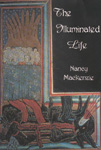The Illuminated Life
by Nancy Mackenzie
Ekstasis Editions, 2002
Reviewed by Joanna M. Weston
 "It is evident from this [the cover] picture that Hildegard [of Bingen] does not repress the shadow side of existence. For all of her
celebration of divine illumination, she never forgets evil" (Illuminations of Hildegard of
Bingen. Text by Hildegard of Bingen
with commentary by Matthew Fox. Bear & Co., New Mexico, 1985. p.95).
"It is evident from this [the cover] picture that Hildegard [of Bingen] does not repress the shadow side of existence. For all of her
celebration of divine illumination, she never forgets evil" (Illuminations of Hildegard of
Bingen. Text by Hildegard of Bingen
with commentary by Matthew Fox. Bear & Co., New Mexico, 1985. p.95).
The illustration, which is shown on the cover of The Illuminated Life
in reverse, is of
a
chained dragon lying on its back in the foot of the 'L', while in the
upright are people dressed in white with tongues of light above them.
These people are clearly trampling the dragon underfoot. The reason for
the reversal is not given.
While Hildegard's expression of good and evil is specific in her
writings as in her art, Mackenzie's is intrinsic but unobtrusive. She
writes, in 'The Essence of Things'
They speak of messages in dreams
and he believes her - the candles sit unlit.
Over coffee she tells him of that vision
where white meets black
and he lights the candles
against the night.
The opposition of male/female, black/white, light/dark.
reality/dreams
are not clearly stated in Mackenzie's perception. She sees them with the
inner eye, leaving the reader to extrapolate the polarities.
Mackenzie subtly echoes of Hildegard's pantheism (the divine essence
present in all things) in the same poem: 'They speak of spirits in all
things .. she plucks a hair from his head/ to fold into her burgundy
book/ of poems all composed in the company of trees.' For Mackenzie it
is 'the spirits' everywhere present. She echoes Matthew's gospel
(Matt.10:30) statement that 'even the hairs of your head have all been
counted' as she takes a hair from her companion's head to fold into her
'book of life', poems written with trees and on the product of trees.
This particular poem is the most explicit regarding the nature
of all
things good but is, as always, with Mackenzie, elusive regarding evil.
'In the night her dog howls wild' and there is an implication of howling
at evil. 'They speak of the wintering/ that devil of future tense/ and
she thinks she will study up north.' The wicked witch of fairy tale
invariably lives in the cold north (cf. George Macdonald) and we catch a
glimpse of the dark side of life.
Mackenzie weaves poems of ordinary life with those subtle ones
of
eternal truths. In 'One Last Look at the Island'
From the kitchen, John's voice mixes with my husband's
as they hunt for cold beer in the fridge.
Liz is away seeing the Daddy plane off.
She moves from the West Coast, across the Prairies, to Scotland and
beyond without indulging in a travelogue but revealing moments and
thoughts of depth, as in 'Take a Map'
an ordinance survey map of standing stones
and madly amass the names of things
places and euphoria.
The irrefutable constancy of strangely weathered stones
encircles me in a name I'll not explain
with a whole alphabet
of stones.
We are encompassed by her delight and wonder at the experience of being
near Stirling Castle, Scotland, with its massive stonework, the
permanence of stones and the inability to explain it.
Mackenzie's poetry, like Hildegard's theology, is both personal and
universal in scope, bringing the reader to question 'Those delusions of
wisdom/ just one more bogey/ to put out of mind before sleep.' While
Hildegard is clear in her profundity, Mackenzie engages the reader with subtlety, coercing into depths of insight.
JOANNA M. WESTON M.A., married, 3 sons, two cats. A chocaholic
writer. Has had poetry published in anthologies and journals, and a
middle-reader THE WILLOW-TREE GIRL. |
| |
TDR is produced in Toronto, Ontario, Canada.
All content is copyright of the person who
created it and cannot be copied, printed, or downloaded without the consent of
that person.
See the masthead
for editorial information.
All views expressed are those of the writer
only.
TDR is archived with the Library
and Archives Canada.
ISSN 1494-6114.
Facebook
page
|